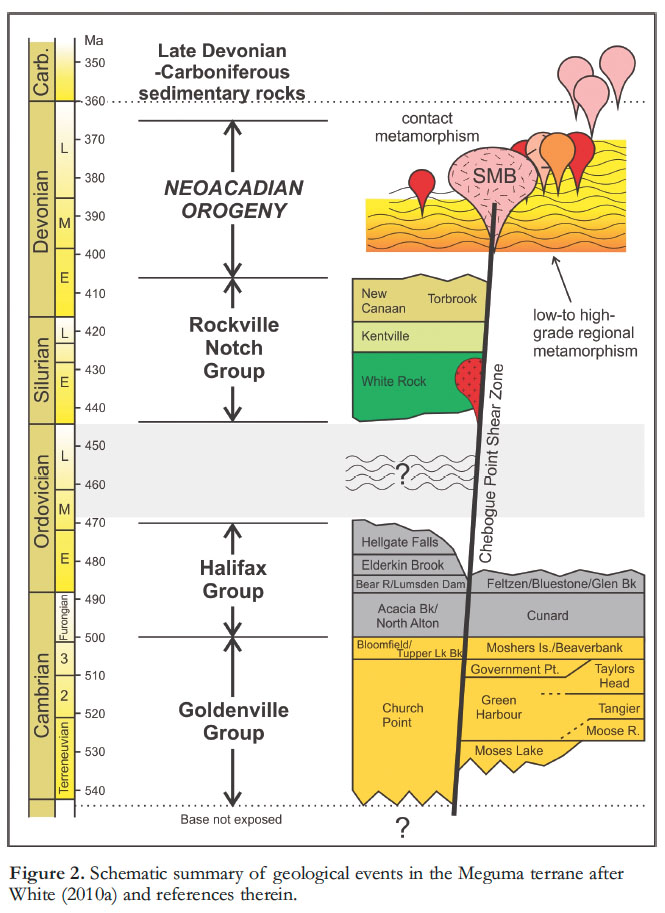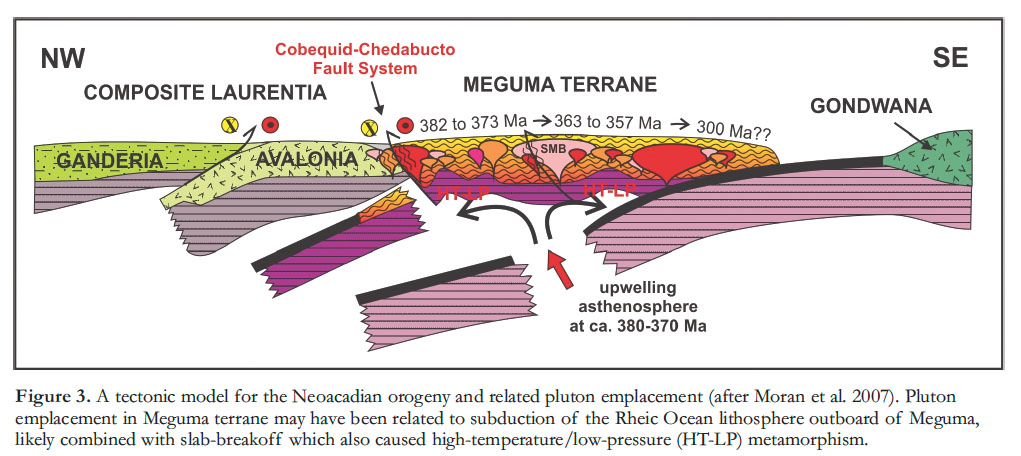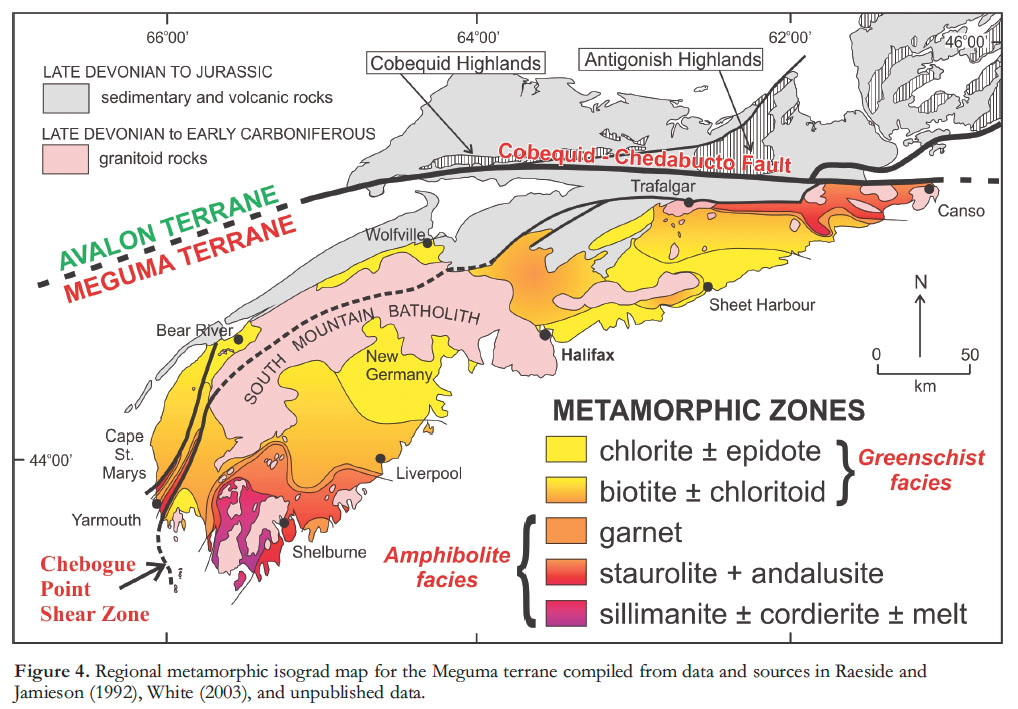GAC-MAC 2012: FIELD GUIDE SUMMARY
Meguma Terrane Revisited:
Stratigraphy, Metamorphism, Paleontology, and Provenance
SUMMARY
1 This field trip highlights our current understanding of the unique geology of the Meguma terrane of southern Nova Scotia, the most easterly (outboard) component of the northern Appalachian orogen (Fig. 1, inset). Recent work has changed previous interpretations of the terrane and provided new insights into its provenance and relationship to other peri-Gondwanan terranes, as well as its history of accretion to composite Laurentia in the mid- to late Paleozoic.
2 The Meguma terrane is characterized by a thick package of Early Cambrian to Early Ordovician turbiditic metasandstone and slate (Goldenville and Halifax groups), locally overlain unconformably by a thin sequence of slate, quartz ite and volcanic rocks (Rockville Notch Group) that ranges from Early Silurian to Early Devonian (Figs. 1, 2). These rocks were de formed and variably metamorphosed (greenschist to amphibolite facies) during the Early to Middle Devonian Neoacadian orogeny (ca. 405–365 Ma), and intruded by numerous, late syntectonic to post-tectonic, mainly Middle to Late Devonian, peraluminous, granitic plutons (Figs. 1, 2). This orogenic event is not yet well understood but was related, at least in part, to dextral transpressive accretion of Meguma terrane against adjacent Avalonia along the Cobequid–Chedabucto fault system. Subsequent Carboniferous motion on the fault system and renewed transpression throughout the Meguma terrane was related to docking of Gondwana (Africa) outboard of Meguma terrane (Fig. 3).
3 Although long considered a monotonous stratigraphic succession, detailed mapping during the past 15 years (e.g. Horne and Pelley 2007; White 2010a, b; White et al. 2009) revealed that the Goldenville and Halifax groups can be divided into regionally extensive and distinctive formations and members (Fig. 2). An example is the High Head member in the lower part of the Goldenville Group (Church Point formation) north of Yarmouth (Fig. 1), which contains a previously undiscovered assemblage of diverse and well preserved Early Cambrian deep water trace fossils (Gingras et al. 2011). A major breakthrough in understanding the stratigraphy was the recognition of a distinctive marker unit, in many places manganese-rich and coticule-bearing, which forms the uppermost unit (100–300 m in thickness) of the Goldenville Group throughout the Meguma terrane (White and Barr 2010). Another important advance was the recognition that the Chebogue Point shear zone (Fig. 1) divides the terrane into northwestern and southeastern parts with stratigraphic differences. The formations of the Rockville Notch Group, as well as two distinct suites of mafic sills and dykes (White and Barr 2004), occur only northwest of the shear zone (Figs. 1, 2).
4 Rocks underlying the Goldenville Group are not exposed and metamorphic rocks in the Trafalgar area in the northern part of the terrane (Fig. 1), interpreted previously to represent possible basement units (e.g. Dostal et al. 2006), have been demonstrated to be the result of contact metamorphism of the Goldenville and Halifax groups around Devonian granitoid plutons (White et al. 2009; Scallion et al. 2011). Gneissic xenoliths in rare mafic dykes in the Sheet Harbour area (Fig. 1) also have been interpreted to represent Meguma basement (Owen et al. 1988; Greenough et al. 1999). Based on age and isotopic signatures, the gneissic xenoliths were inferred to have been derived from underlying Avalonian crust, and have been used as evidence for the argument that Meguma has Avalonian basement (Murphy et al. 2004). Seismic data show that the leading edge of Meguma has been thrust over Avalonia (e.g. Keen et al. 1991a, b; Loncarevic et al. 1989), presumably during the Neoacadian orogeny, but their original relationship remains unknown.
5 Meguma is generally accepted to be a peri-Gondwanan terrane, although the specific location along the margin of Gondwana where it originated remains speculative. Traditionally, the Goldenville and Halifax groups were interpreted to have been deposited on the continental rise and/or slope to outer shelf of a passive margin that was part of, or adjacent to, the North African craton during the Cambrian, perhaps in close association with Armorica (Schenk, 1971, 1981, 1991, 1997), but Amazonian connections now appear more likely (e.g. Keppie 1977; Waldron et al. 2009). Meguma also has been inferred to be part of and/or to have travelled with Avalonia (e.g. Landing 2004; Murphy et al. 2004; Nance et al. 2008).
 Display large image of Figure 1
Display large image of Figure 16 Waldron et al. (2009) concluded that the stratigraphic differences across the Chebogue Point shear zone, combined with similarities to Avalonian detrital zircon populations, juvenile Nd isotopic compositions, and sparse faunal evidence indicating Avalonian affinity (Pratt and Waldron 1991), suggest that the Meguma terrane formed in a rift between Gondwana (Amazonia) and Avalonia. Based on detrital zircon signatures, Barr et al. (in press) demonstrated similarity in the Early Cambrian but diverging subsequent histories after that. Rifting at ca. 520–500 Ma may have moved Avalonia away from Gondwana but Meguma moved later (Late Ordovician–Early Silurian) as evidenced by bimodal volcanism in the White Rock Formation (MacDonald et al. 2002). Waldron et al. (2011) emphasized similarities in the Cambrian to Tremadocian successions of the Meguma terrane to those of the Harlech Dome of North Wales, and proposed that both areas were part of a ‘Megumia domain’ that occupied a rift in the margin of Gondwana.
FIELD TRIP ITINERARY
7 Day 1 will focus on the stratigraphy and metamorphism of the Goldenville and Halifax groups along the ‘south shore’ of Nova Scotia, east of the Chebogue Point shear zone, as well as some of the granitoid plutons that intruded those units. Stops will include the pyrite-rich Cunard Formation of the Halifax Group and underlying manganiferous Moshers Island, Government Point, and Green Harbour formations of the Goldenville Group at both low and high metamorphic grades, the latter including the spectacular low-pressure/high-temperature andalusite–cordierite–staurolite metapelite in the Shelburne metamorphic culmination (Fig. 4).
8 Day 2will look at rocks northwest of the Chebogue Point shear zone, including the Goldenville and Halifax groups and metavolcanic and fossiliferous metasedimentary rocks of the Silurian White Rock Formation of the lowermost Rockville Notch Group. We will view the oldest exposed beds of the Goldenville Group and the trace fossils of the High Head member as documented by Gingras et al. (2011), and the enigmatic contact between the Halifax Group and White Rock Formation, variously described in the past as conformable, unconformable, faulted, and tectonically imbricated.
9 During Day 3we will focus on stratigraphy in the upper part of the Goldenville Group and the overlying Halifax Group in the Bear River and Wolfville areas, looking at typical localities for new formations defined in the Halifax Group in that area, ages of which are well constrained by acritarch fossils (White et al. 2011).
10 For those interested, an optional Day 4, not included in the formal part of the field trip, will consist of stops in the Trafalgar area to view the manganiferous garnet developed in granitoid rocks of the Trafalgar plutonic suite as a result of interaction with manganiferous rocks of the Beaverbank formation.
 Display large image of Figure 2
Display large image of Figure 2 Display large image of Figure 3
Display large image of Figure 3 Display large image of Figure 4
Display large image of Figure 4